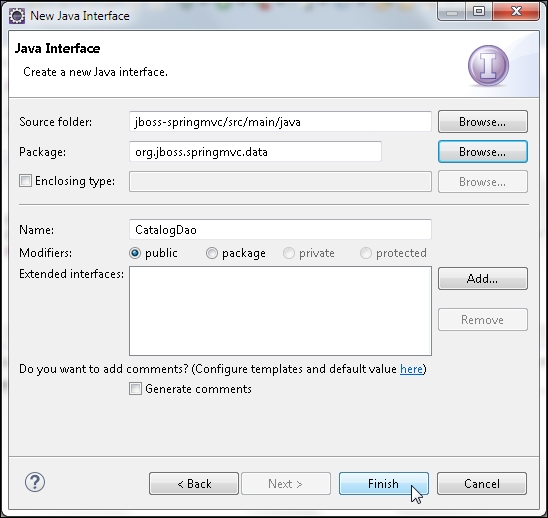The advantages of the Data Access Object design pattern, such as reusable software and decoupling of the business logic and database persistence logic, are well established. We shall use the DAO design pattern for the data access layer. The DAO design pattern will provide standard operations for persisting a Catalog entity instance and getting Catalog entity instances. Create an org.jboss.springmvc.data.CatalogDao Java interface, as shown in the following screenshot:

Add method definitions for the persist(Catalog) methods to persist of the Catalog object and getAllCatalogs() to get List of Catalog objects. The CatalogDao interface is listed in the following code:
package org.jboss.springmvc.data;
import java.util.List;
import javax.persistence.TypedQuery;
import org.jboss.springmvc.model.Catalog;
public interface CatalogDao
{
public void persist(Catalog catalog);
public List<Catalog> getAllCatalogs();
}Create an
org.jboss.springmvc.data.CatalogDaoImpl implementation class to implement the org.jboss.springmvc.data.CatalogDao interface. Annotate the class with @Component, which makes the class a "component" that is auto-detected using class-path scanning when we use annotation-based configuration. In the resources/META-INF/spring/applicationContext.xml application context configuration file, auto-detection of the org.jboss.springmvc.data package gets configured with the following <context:component/> element within the <beans/> element:
<context:component-scan base-package="org.jboss.springmvc.data" />
Spring MVC autodetects the CatalogDaoImpl class and injects a CatalogDaoImpl object, catalogDaoImpl, into any @Autowired field, method parameter, or constructor parameter of the type CatalogDaoImpl. Annotation-based transactions are configured using the following declaration in applicationContext.xml:
<tx:annotation-driven />
The \jboss-springmvcsrcmain
esourcesMETA-INFspringapplicationContext.xml file is listed in the following code:
<?xml version="1.0" encoding="UTF-8"?> <beans xmlns="http://www.springframework.org/schema/beans" xmlns:context="http://www.springframework.org/schema/context" xmlns:tx="http://www.springframework.org/schema/tx" xmlns:xsi="http://www.w3.org/2001/XMLSchema-instance" xsi:schemaLocation="http://www.springframework.org/schema/beans http://www.springframework.org/schema/beans/spring-beans-3.2.xsd http://www.springframework.org/schema/context http://www.springframework.org/schema/context/spring-context-3.2.xsd http://www.springframework.org/schema/tx http://www.springframework.org/schema/tx/spring-tx-3.2.xsd"> <context:component-scan base-package="org.jboss.springmvc.model" /> <context:component-scan base-package="org.jboss.springmvc.data" /> <tx:annotation-driven /> </beans>
Annotate the persist(Catalog) method with @Transactional. Inject EntityManager into the DAO implementation class using the @PersistenceContext annotation. The persist() method of EntityManager is used to persist a Catalog instance. To retrieve all Catalog instances, create a TypedQuery object using the createQuery method of the EntityManager object. Obtain a List<Catalog> object as a result using the getResultList() method of the TypedQuery object. The org.jboss.springmvc.repo.CatalogDaoImpl DAO implementation class is listed in the following code:
package org.jboss.springmvc.data;
import org.jboss.springmvc.model.*;
import java.util.List;
import javax.persistence.EntityManager;
import javax.persistence.PersistenceContext;
import javax.persistence.TypedQuery;
import org.springframework.stereotype.Component;
import org.springframework.transaction.annotation.Transactional;
@Component
public class CatalogDaoImpl implements CatalogDao
{
// Injected database connection:
@PersistenceContext private EntityManager em;
// Stores a new catalog:
@Transactional
public void persist(Catalog catalog) {
em.persist(catalog);
}
// Retrieves all the catalogs:
public List<Catalog> getAllCatalogs() {
TypedQuery<Catalog> query = em.createQuery(
"SELECT c FROM Catalog c ORDER BY c.id", Catalog.class);
return query.getResultList();
}
}